adj1. a Of or relating to energy or to objects in motion.
2. Characterized by continuous change, activity, or progress: a dynamic market.n1. An interactive system or process, especially one involving competing or conflicting forces: "the story of a malign dynamic between white prejudice and black autonomy"(Edmund S. Morgan).
Building from these common definitions a video game dynamic can be thought of as any interactive system within a game. This is a very general definition that can apply to music, graphics, and gameplay systems alike.
Using the word "dynamic" to describe gameplay requires a more exact definition. A gameplay dynamic is a system where one action has a range of influences on gameplay elements, features, and/or challenges.
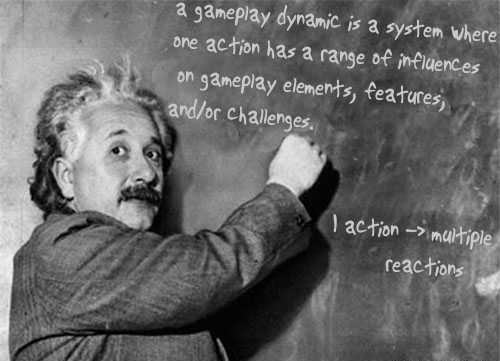
To put it simply, a gameplay dynamic is when one action has multiple reactions that influence gameplay elements. Going by this criteria alone, it's easy to come up with examples of gameplay dynamics that have a large effect on a game's gameplay and other examples that have a very small effect. A good example of a very small gameplay dynamic is the music in New Super Mario Brothers. In this game, there are specific moments during the soundtrack that trigger enemies on the screen to dance. During these small cues Koopa perform a little side step move, Goomba jump, and Cheep-Cheep swim in a circle. If you're not paying close enough attention, the small change in timing from a dancing enemy could be just enough to throw off your aim.
As evident from the NSMB example, gameplay dynamics that have a very small effect on gameplay can be very subtle and specific with effects that are very infrequent. For the purposes of this article, I will focus on gameplay dynamics that are much more common and that affect a significant amount of the gameplay elements. Such dynamics are called core gameplay dynamics or core dynamics.
Let's break it down.
SPACE
I can't think of many games that don't use space as a core dynamic. Likewise, time is also a widely use core dynamic because its couples well with space. Because time is a bit more complicated, I'll start with space.
Any game system with characters or objects that move, touch, hit, and/or dodge to reach a goal use the core dynamic of space. Take Pong for example. Pong is a game that simulates table tennis like gameplay. Players have to move their paddles through space anticipating the trajectory of the ball and make contact with the ball to continue the volley. Every instant the ball moves, it's changing its position on the screen (in space) in addition to the relative distances between each paddle and the walls. For every movement (1 action) the positions (both relative and actual) of every element in the game changes. This is the basic idea behind the dynamics of space.
Everything from the advance spacing involved in fighters, taking cover in a shooter, flipping blocks in Planet Puzzle League, to jumping over Goomba uses the dynamic of space. Different games can use the dynamic of space differently which in turn influences gameplay in very specific ways.
- 2D top down
- Because there's so much space the player can freely move through, challenges in top down games are generally designed to limit the player's options by filling the screen, surrounding, or homing in on the player. In other words, the real challenge comes when players are trapped against walls or by multiple contrary enemy elements.
- Chess, The Legend of Zelda, Neo*RPG, Geometry Wars. (more examples)
- 2D side scrolling (Gravity)
- The key difference of the space dynamic between top down and side scrolling games is gravity. Gravity (1 force) is a dynamic that works against many gameplay elements in the game. Take Super Mario Brothers. Because Mario is constantly pulled to the ground, it's easier to create contrary motion against the player by way of enemies that also walk along the ground. All the elements that are influenced by gravity (Mario, some enemies, fireballs, powerups, etc) layer well with those that don't (some platforms, some enemies, etc).
- Super Mario Brothers, Super Smash Brothers, Braid, Mighty Flip Champs. (more examples)
- 3D Space
- The 3rd dimension really adds a lot to the dynamic of space. In 3D environments, every movement of an object changes its relative distance from every other object in 3 axes instead of just 2. This inherently makes moving through space in 3D games more dynamic and complex than in 2D games. Because games that feature 3D space as a core dynamic can also feature gravity, all of the influences of 2D dynamics (described above) can also apply to games with 3D space. Read more about it in the link above.
- Halo 3, Ninja Gaiden, Super Mario 64/Sunshine/Galaxy.
TIME
Most games function in real time meaning the game actively processes player input (or the lack thereof) and changes the game state accordingly. This happens many times a second. Whether the game is real time or turned based, there are many factors in a game that are active. Perhaps in games like untimed Chess when one player is thinking of their next move the game has practically stopped. But for most video games, time marches on. This is not to say, however, that time is a core dynamic of gameplay.
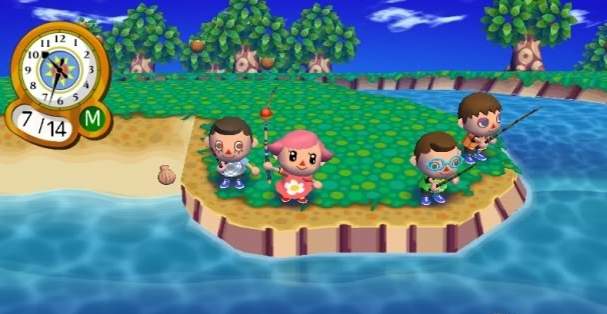
For time to be a core gameplay dynamic the structure of the challenges (or core interactivity) must change with time. For games that use space as a core dynamic, this comes naturally. For example, a Goomba walking toward Mario is an organic timer. Every second the Goomba gets closer and closer to hurting Mario. And every step Mario takes closer to the Goomba, the distance and timing changes. In this way the relative distances in space are proportionate to the relative timing between objects.
For another example, the time Mario invests in jumping affects where he can land and when. "What goes up must come down." These concepts should be very familiar to us. This is why time and space are natural/organic dynamics. Because these dynamics are a part of our ordinary lives, they're easy to grasp. It's no wonder they're so widely used in video games.
The dynamics of time usually accompanies the dynamics of space in the design of a game. Other than this natural dynamic of time, there are a few other types:
- Time: Decay and Rates
- In a game where key resources are accrued over time the difference between executing a maneuver now and the same maneuver 5 seconds later can be the difference between victory and defeat. In Star Craft, resources take time to mine, buildings take time to erect, energy takes time to charge, units take time to travel, and upgrades take time to research. Everything is balanced by time. The player is constantly thinking about time. Strategies are built around attacking economies that grow over time. And matches can become wars of attrition. It's no wonder we have a whole genre dedicated to the core dynamic of time.
- Real Time
- In Animal Crossing, real life time is a core dynamic. Depending on the time of day or day of the year, the entire game world is affected. Holidays come and go. Opportunities and grudges pass. Animals move in or out. Your house may get roaches. Weeds grow. Stores close. And your mail box may overflow. Whether you're playing the game or not, every second affects the range of interactivity you can have with the game world.
- In Metal Gear Solid 3: Snake Eater your in game rations can spoil after an amount of game time passes. Also, The End is a very old boss character in the game that player can overcome by waiting a week of real time so that he dies of old age. Though these features are not core to the game, they're neat nonetheless.
ARTIFICIAL DYNAMICS
If space and time are natural dynamics, the flip side of the coin would mean that there are artificial dynamics. These dynamics are usually game rules that are implemented to make things more fair or interesting. Artificial dynamics generally have less influence on gameplay and player decisions than core dynamics because they deal with specifics.
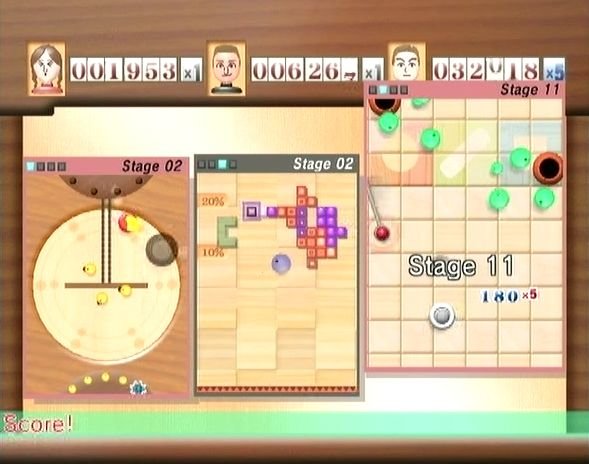
Artificial dynamics are also used to connect actions to what would otherwise be unrelated elements. For example, in Halo 3 and ODST the Black Eye skull that adds a new dynamic to combat. Normally, player's health/shield regenerate as long as they're not being attacked. But with this skull players can only get their health back by melee attacking enemies. In this way, the Black Eye skull dynamic connects two completely unrelated elements of design; melee attacks and player health.
- CO Meter: In the Advance Wars series (except Days of Ruin) whenever you give damage or take damage, part of your and your opponent's CO meter is built up. It is nearly impossible to win games without contributing to these meters. Once full, players can unleash devastating and game changing attacks. So, for every offensive or defensive action, the unit health is affected in addition to the CO meters.
- Ultra Meter (Street Fighter 4): Like in Advance Wars your revenge gauge or ultra meter fills up when you take damage. The more you get beat up, the more powerful your ultra attack becomes. There's no way to win a round without filling up your opponent's gauge.
- Hybrid dynamic (Henry Hatsworth): HH is designed so that the player actions from the top or bottom screen influence the other screen. Kill an enemy on the top screen, and it'll move to the bottom screen. Eliminate it on the bottom screen, and that enemy will be converted to energy for the top screen. The cycle goes back and forth. See link above for more information.
- Semi hybrid game dynamic (Maboshi's Arcade) (video): This strange and unique game is actually 3 games that can be played by 3 players all at once or by 1 player playing with replays. Each game is simple and interesting individually. But when played side by side the games have elements that affect each other. So you can effectively help your self out from the moves you made in the past. That's 1 action for several emergent results.
THE HUMAN DYNAMIC
Another dynamic in game systems is the human dynamic. These dynamics are found in multiplayer games.
- Free For Alls: In FFA games it's every man, woman, alien, robot, etc. for themselves. Alliances can be made and broken all in a player's attempt to look out for themselves. Some players may be weak making for easy targets. In these cases, the battle dynamic can shift from "who can get the most points by killing anyone" to "who can get the most points by killing a specific player." Whatever the case is, every action made by each player changes the game for everyone.
- Co-op: In situations where cooperation and teamwork are necessary, the player(s) that you need to work with to win and your ability to work with them is a dynamic all in itself. If you need to stick together and one or more of your teammates move in opposite directions what do you do? If one player won't listen to your plans, are the other players able to play off of the stubborn one? Once again, the actions of one can instantly affect the game for others.
- Co-unter-op: The dynamics of co-ounter-op situations are a mix between the dynamics of FFA and co-op. At one point, everyone may be working together. And at another, one player may try to do things in his/her best interest. The Force gems in The Legend of Zelda: Four Swords come to mind. Just sprinkle a few of those "valueless" gems out on the field and watch as your friends instantly become enemies.
To end this article I wanted to briefly talk about....
GAMES WITHOUT DYNAMICS
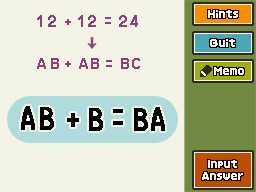
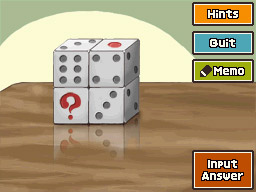
- Some puzzle games don't have have any gameplay dynamics. For example, some of the puzzles in Professor Layton require the player to input the right answer from a question prompt (see images above). Sometimes the answer is a letter. Sometimes a number. And sometimes it's multiple choice. There's only one right answer for these puzzles. If you get it, good for you. If you miss it, you get to try the same problem again. The game looks for one input to pair with the success result. All other input just repeats the cycle. 1 action for 1 results isn't dynamic.
- Many music rhythm games are not dynamic. Whether you miss the timed input or not, the game will keep rolling. Throughout the song, the game won't get any harder or easier based on player performance. The challenge is designed to be the same from start to finish every time. A set "roller coaster" ride may be fun, but it's not dynamic.